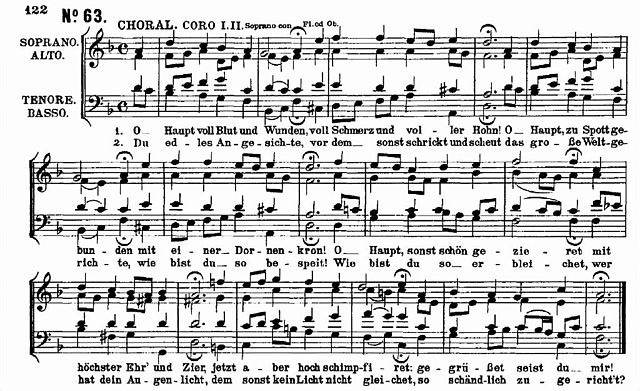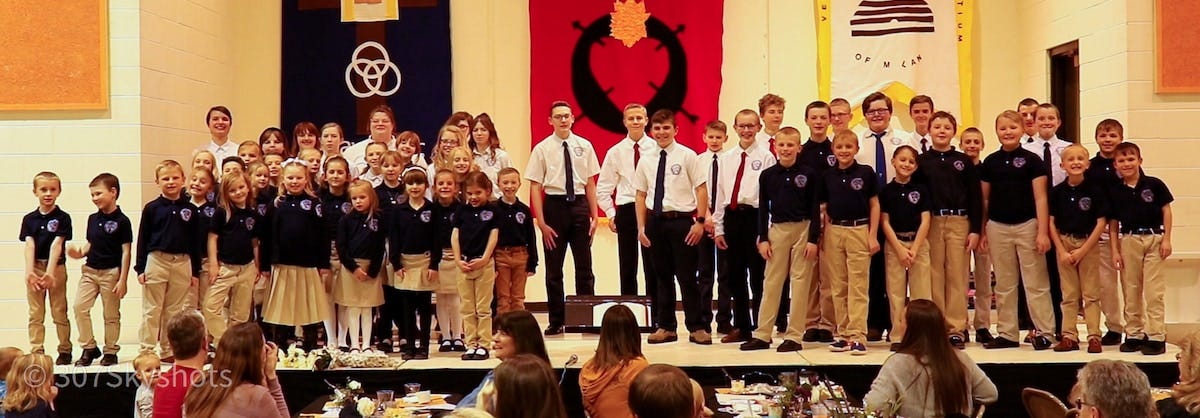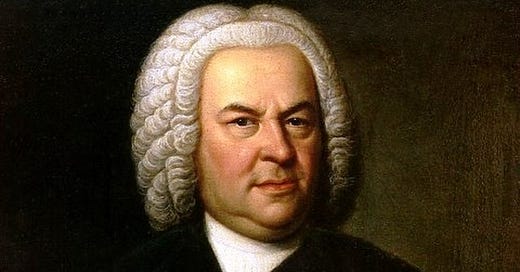J.S. Bach, for you
A new way for you to learn great Lutheran music at the Bach to Church Project
In east central Germany, in the city of Leipzig, stands an old church. It’s the St. Thomas Church, known in German as the Thomaskirche. It first existed as a monastery church in 1212. Sometime around the time that Christopher Columbus sailed the ocean blue, builders finished transforming what had been a Romanesque church into the arched, cavernous Gothic nave that still, with some more modern updates, exists today. That means the Thomaskirche you can walk into in 2023 has been around for more than 500 years.

While the church building itself is beautiful, and its longevity impressive—take note, modern architects!—what really makes the Thomaskirche important to us is what has emerged from within its walls. That is, this one church has incubated sacred music that has gone on to change the world. More specifically, this music has confessed Christ with unflinching clarity and beauty to a world desperate for the Truth.
I could mention several composers connected with the Thomaskirche. Richard Wagner was baptized there, and Felix Mendelssohn was responsible for unearthing near-forgotten treasures there (just for that I have a soft spot in my heart for him). But you know I’m talking mainly about the music of the greatest composer who has ever lived: Johann Sebastian Bach.
Though J.S. Bach was a faithful and devout Lutheran, I’d venture a guess that most Lutherans hear his name and think of music beyond our reach—ethereal choirs, vast and momentous orchestras, intricate and literally foreign words and melodies. Even a few highlights of his life and work can sound overwhelming. His compositions were so ground-breaking that he literally invented how we understand counterpoint. He played multiple instruments himself, but his contemporaries recognized him as a master organist (and many of his organ works show, through their very intricacy and difficulty, how high he set the bar—just listen to the Little Fugue!). He wrote domestic music for the keyboard for his family, to help them learn music, and he wrote secular music like the Brandenburg Concertos in a prince’s court, all of which we still enjoy and play today. He was so prolific in writing as the kapellmeister, or music director, in his twenty-seven years at the Thomaskirche, that you can hear one of his cantatas for every day of the liturgical year. He wrote so much music, so beautifully and powerfully, for so many people, from princes to parish paupers, that he doesn’t even seem real. If we’re honest, Bach intimidates us. And in turn, his music intimidates us, too.

I’d like to say that the music of J.S. Bach became real to me when I was standing in the balcony at the Thomaskirche in 2004 with my collegiate choir, singing one of his cantatas. (Yes, in the same balcony pictured above. It is higher up than it looks.) The same goes for singing Bach’s Mass in B Minor in a huge ensemble with professional soloists and an extensive orchestra, all directed by the renowned Bach scholar Helmuth Rilling. Both experiences were unforgettable, and I wouldn’t trade them. But they were both far, very far, from my daily life.
In recent years, I have to admit that Bach and his music became more accessible to me in my car, during one of many kid-shlepping trips, while we all listened to Mr. Bach Comes to Call. It’s a fictionalized account of Bach paying a visit to an unenthusiastic piano practitioner—a little girl who knows next to nothing about the great composer. Maybe it’s the German touches when he sends off his choir for a snack: “Yah, yah—go get apfelkuchen mit Sahne [apple pie with cream] and come right back!” Or when he makes the potential understatement of the last half-millennium with “I wrote some pretty good stuff there,” referencing the sublime “Jesu, Joy of Man’s Desiring.” More likely, though, I’ve learned how the real tragedies of Bach’s life, from becoming an orphan by the time he was ten, to sitting in a Duke’s prison for a time, to suddenly losing his first wife, obviously shaped him. God can turn suffering into great blessings, and He did so in Bach. “They said I was wasting my time!” Bach fumes to the little girl. “I didn’t write my music for them—I wrote it for God!”
And therein lies Bach’s great gift to us. In writing music for God, Bach did write for us. So did every other great Lutheran composer, who likewise wrote for the glory of God first, and whose offerings have since been left to posterity. But a void exists. How can this music be included in our lives? In our mostly small, enthusiastic but decidedly non-professional church choirs? In our living rooms with our children during devotions, when we seek to mine the treasures of our hymnals?
Now, we have an invaluable resource to learn about and from this great music which confesses our faith in the Bach to Church Project.
So what is it? In essence, it’s a website that aims to make great Christ-confessing music from wonderful Lutheran composers and writers available to anyone who wants them, but to families and congregations specifically. In our digital age, this means offering printable music and audio recordings in an easily accessible, searchable format. And it’s free, too! But the Project is much more than yet another online music database. From the Project’s About page:
The Lutheran Church has a rich musical heritage, and we want that heritage available to Lutheran congregations and schools. There are many beautiful settings of beloved Lutheran hymns, written by some of the greatest choral composers the world has ever seen. A good many of these choral settings lie scattered online, somewhat accessible (with German words) to those who know where to look, but not easily found and not ready for use in English. A few have seen the light of day in Lutheran choir books. We’re glad that our heritage has never been completely lost, and we’re very grateful to others who have set about preserving it. But many more treasures lie hidden, and they should be readily available to our Lutheran congregations and schools.
So Bach, and all wonderful Lutheran composers, can be and are for us. Hear, hear!
The founders of this project are near and dear to my heart, and to those of my family. They are Pastor Andrew Richard, Ms. Hannah Engwall, Ms. Anna Hahn, and Mr. Nathanael Hahn, the teachers at Mount Hope Lutheran School, a classical K-12 Lutheran school here in Casper, Wyoming. All of them teach our children, and we are so thankful for their clear confessions of the faith and tireless dedication to bringing what is the best of beauty and goodness in service to the Truth to their students. I asked them to share about their motivations and interests in this project, and they were gracious enough to reply.

Pastor Richard is the headmaster at MHLS and teaches humanities to the upper level (the middle and high school students). He sings tenor in the teacher quartet featured in most of the uploaded recordings. Bach is Pr. Richard’s favorite composer—no surprise there!—and his music was instrumental to the Project. “The chorale BWV 385, "Now Do We Pray God the Holy Ghost," will always hold a special place in my heart because it was the first Bach chorale I ever sang and the first one we teachers sang together,” he said. He also noted a “Where’s Waldo” look-see on the website: if you look closely, that chorale is the melody featured in the Bach to Church logo.
Pastor Richard’s interest in the project stems in no small part from the music’s deep theological grounding. “There's something about such music that transcends earth, not in some mystical sense, but as a concrete aid in following the words in Colossians 3, ‘Set your mind on things above, not on things on the earth. For you died, and your life is hidden with Christ in God.’” Anna Hahn, who teaches the third through fifth grades and a Latin class at MHLS, sings alto and agrees with Pastor Richard. “The music is matchless not only in its own right, but especially because it illuminates rich theological texts (which are also an interest of mine).” It’s also enjoyable personally to her, too. “The chance to actually learn and sing these pieces is simply wonderful!”
Hannah Engwall teaches kindergarten through second grade students, as well as teaching advanced music theory and conducting the Kammerchor, an audition choir, at Mount Hope. Her experience with and background in music have contributed to her interest. “I have always loved music, and growing up I was heavily involved in church music, singing in choir, playing handbells, and then playing the organ,” she says. (The lineage of wonderful Lutheran organists continues with Hannah. You can hear her play here). Later, “I discovered how much I enjoyed music theory and composition.” A soprano, Hannah says that “singing in the recordings for the site and teaching some of the pieces to my choirs to record has been a delightful extension of what I already enjoy doing.”

Nathanael Hahn, an award-winning composer himself, is the Upper Level Quadrivium teacher (math and science, as well as Latin and music theory, too) at MHLS. Like Hannah, he credits his interest in music with motivating him in the Project, and like Pastor and Anna, he deep dives into the theology expressed in the music. “Since I love composing music myself, I'm highly interested in our musical heritage as Lutherans, not only to learn from the great composers of our Church, but also to enjoy the beauty those men brought with their music. How these hymn writers and composers married music and theology with such skill is truly astounding.”
The teachers hold other detective-like and curating skills that have greatly contributed to their work for the Project. For Hannah, Bach to Church is a lodestone of her passion for music theory and sharing it with others. “[The Project] requires some work hunting down good scores and then transcribing them into notation software, which has been a way for me to combine my appreciation for studying scores with making the scores more practically available for use in the church,” she explains. Nathanael really understands the music programming that allows him, and all of them, to share the music and texts online. “I've also really come to enjoy engraving music”—that is, the ability to translate old music from photos or even hard copies to high-quality notation. I’ve watched him do this, and though it’s tedious work, it’s also mesmerizing and very helpful to rank amateur engravers like me.
Pastor Richard, too, has technical knowledge that has made Bach to Church possible for the rest of us. Along with designing and building the website, “I have run a small recording studio as a hobby for over twenty years. My father taught me how to do it when I was in high school, and I've loved recording ever since.” His time at MHLS has opened new doors for his recording pursuits. “For the last few years I've been focused exclusively on recording choirs, and now I use choir recordings for the Project to inspire people to learn and help them as they practice.” (You can listen to MHLS choirs here.)

As classroom teachers, all four immerse their students in quality Lutheran music. So the Bach to Church Project, as Pastor Richard points out, has “flowed naturally from what's happening at MHLS. We sing good hymns in chapel every day. All students and teachers regularly listen to beautiful choir pieces by these composers in our classrooms during study periods and study them in music theory classes.” Kammerchor singers learn and perform choral settings of Lutheran hymns by Bach, Michael Praetorius, Johannes Eccard, Samuel Scheidt, Johann Walter, Johann Crüger, and others. As Nathanael notes, even students who are still mastering more difficult music “can learn what's out there that that they could perform in the future.” And Anna sees another benefit for students to be surrounded by such music. “I think it's invaluable for students to know their musical forefathers, not only to be edified by the music itself, but also to have models before them of what happens when talent, hard work, and Christian joy respond to the Gospel!”
Finally, though Bach remains a favorite of all of the teachers, they’re currently interested in different composers and pieces (no, they didn’t coordinate their answers). Pastor Richard has lately “been delighted with Johannes Eccard's five-part settings. My favorite by him is "In Thee Alone, O Christ, My Lord," both because it's one of my favorite hymns and because the setting is marvelous.” Nathanael insists that his favorite composer “has to be Johann Crüger. I admire him because of how skilled he was at creating absolutely beautiful melodies. In some ways, I picture him like the 16th century Lutheran John Williams, because if you hear a beloved hymn tune that's stood the test of time, there's a pretty good chance it was written by Crüger.” You can hear Crüger’s “Christ Jesus Lay in Death’s Strong Bands” at the Project here.

Anna’s favorite composer is Michael Praetorius. “His music is, in my opinion, the perfect marriage of joy and reverence in sacred music. I love his use of multiple choirs, his keen intentionality in text-painting, and his personal piety and devotedness to Christ. His Christmas Mass is simply glorious—certainly my favorite of his works.”
Hannah highlights yet another great composer and piece. “My current favorite is “Nun bitten wir” by Johann Walter” (you can watch a video of a choir singing it here). “This is a five-part choral piece that has the cantus firmus sung in a canon between two voices, while the other three voices imitate each other.” For the layperson, this basically means that two parts sing a melody designed to be layered, or sung at different times by different parts, in a round (think “Row, Row, Row Your Boat”), all while the other three parts sing complimentary voice parts. As Hannah notes, “the form of this piece is a marvel in its intricacy, and the results are beautiful. I appreciate that something written almost 500 years ago is still able to impact listeners and performers alike with its gorgeous melodic lines and rich texture, along with the theological meaning of the text.”
Let’s hope the teachers can record this piece, and others like it, soon! As Pastor Richard says, “Singing together is one of our favorite pastimes. Sometimes after a hard day or week at school one of us will say, "I need to sing," and we'll all go to the sanctuary and praise Christ and taste heaven and lay aside earthly care.” As the teachers are learning, “[if] such beautiful order and harmony can come from the pen and voices of mortals in this life—songs which seem to echo of heaven even when imperfectly sung—imagine what heaven itself will be like!” May we all enjoy a foretaste of our life to come in this beautiful music, music that with God’s help will continue to echo within our churches and beyond, and with some much-appreciated help from the Bach to Church Project.
Please explore, subscribe, and donate to the Bach to Church Project here.




Excellent piece. Thank you! XO